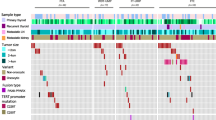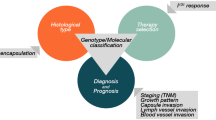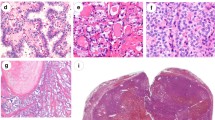Abstract
The diagnostic and clinical approaches to follicular-patterned thyroid neoplasms often create dilemmas for pathologist and clinicians. The molecular analysis of these tumors could be a useful tool to overcome diagnostic limitations. The most frequent molecular alterations are point mutations of RAS family genes. Nevertheless, other molecular markers should be taken into account for their prognostic role, as BRAF mutations and the recently described telomerase reverse transcriptase (TERT) promoter mutation. We investigated the prevalence and the possible role of TERT promoter, BRAF, and RAS mutations in a series of low-risk well-differentiated follicular-patterned thyroid neoplasms. We evaluated 60 follicular adenomas (FA), 29 minimally invasive follicular carcinomas (MIFTC), 82 papillary carcinomas, follicular variant (FVPTC), and 16 noninvasive follicular thyroid neoplasms with papillary-like nuclear features (NIFT-P) for the molecular status of BRAF, H-, N-, K-RAS, and TERT and correlated it with clinic-pathological parameters of tumors. Fifty-seven (30.5%) follicular neoplasms were mutated. In particular, we found 44 RAS mutated neoplasms (23.5%), specifically three FAs, 29 FVPTCs, five NIFT-Ps, and seven FTCs. BRAF mutations were found in ten FVPTCs. Finally, TERT promoter mutations were observed in three FVPTCs and three FTCs; three of them harbored also N-RAS mutations. We confirmed the absence of TERT promoter mutations in benign follicular neoplasms and found a low frequency of TERT promoter mutations in our selected cohort of low-risk follicular-patterned malignancies, speculating their role in the progression and de-differentiation of thyroid cancer.
Similar content being viewed by others
References
Albores-Saavedra J, Henson DE, Glazer E et al (2007) Changing patterns in the incidence and survival of thyroid cancer with follicular phenotype-papillary, follicular, and anaplastic: a morphological and epidemiological study. Endocr Pathol Spring 18:1–7
Jung CK, Little MP, Lubin JH et al (2014) The increase in thyroid cancer incidence during the last four decades is accompanied by a high frequency of BRAF mutations and a sharp increase in RAS mutations. J Clin Endocrinol Metab 99:E276–E285. https://doi.org/10.1210/jc.2013-2503
DeLellis RA, Lloyd RV, Heitz PU et al (2004) World Health Organization classification of tumours. Pathology and genetics of tumours of endocrine organs. Eds. IARC Press, Lyon
Jemal A, Bray F, Center MM et al (2011) Global cancer statistics. CA Cancer J Clin 61:69–90. https://doi.org/10.3322/caac.20107
Brown RL, de Souza JA, Cohen EE (2011) Thyroid cancer: burden of illness and management of disease. J Cancer 2:193–199
Tuttle RM, Ball DW, Byrd D et al (2010) Thyroid carcinoma. J Natl Compr Canc Netw 8:1228–1274
Rosario PW, Penna GC, Calsolari MR (2014) Noninvasive encapsulated follicular variant of papillary thyroid carcinoma: is lobectomy sufficient for tumours ≥1 cm? Clin Endocrinol 81:630–632. https://doi.org/10.1111/cen.12387
Rivera M, Ricarte-Filho J, Knauf et al (2010) Molecular genotyping of papillary thyroid carcinoma follicular variant according to its histological subtypes (encapsulated vs infiltrative) reveals distinct BRAF and RAS mutation patterns. Mod Pathol 23:1191–1200. https://doi.org/10.1038/modpathol.2010.112
Ganly I, Wang L, Tuttle RM et al (2015) Invasion rather than nuclear features correlates with outcome in encapsulated follicular tumors: further evidence for the reclassification of the encapsulated papillary thyroid carcinoma follicular variant. Hum Pathol 46:657–664. https://doi.org/10.1016/j.humpath.2015.01.010
Vivero M, Kraft S, Barletta JA (2013) Risk stratification of follicular variant of papillary thyroid carcinoma. Thyroid 23:273–279. https://doi.org/10.1089/thy.2012.0369
Baloch ZW, Shafique K, Flannagan M et al (2010) Encapsulated classic and follicular variants of papillary thyroid carcinoma: comparative clinicopathologic study. Endocr Pract 16:952–959. https://doi.org/10.4158/EP10060.OR
Nikiforov YE, Seethala RR, Tallini G et al (2016) Nomenclature revision for encapsulated follicular variant of papillary thyroid carcinoma: a paradigm shift to reduce overtreatment of indolent tumors. JAMA Oncol 1(2):1023–1029. https://doi.org/10.1001/jamaoncol.2016.0386
Proietti A, Sartori C, Borrelli N et al (2013) Follicular-derived neoplasms: morphometric and genetic differences. J Endocrinol Investig 36:1055–1061. https://doi.org/10.3275/9063
Smekalova EM, Shubernetskaya OS, Zvereva MI et al (2012) Telomerase RNA biosynthesis and processing. Biochemistry 77:1120–1128. https://doi.org/10.1134/S0006297912100045
Mocellin S, Pooley KA, Nitti D (2013) Telomerase and the search for the end of cancer. Trends Mol Med 19:125–133. https://doi.org/10.1016/j.molmed.2012.11.006
Horn S, Figl A, Rachakonda PS, Fischer C et al (2013) TERT promoter mutations in familial and sporadic melanoma. Science 22(339):959–961. https://doi.org/10.1126/science.1230062
Landa I, Ganly I, Chan TA et al (2013) Frequent somatic TERT promoter mutations in thyroid cancer: higher prevalence in advanced forms of the disease. J Clin Endocrinol Metab 98:E1562–E1566. https://doi.org/10.1210/jc.2013-2383
Liu T, Wang N, Cao J et al (2014) The age- and shorter telomere-dependent TERT promoter mutation in follicular thyroid cell-derived carcinomas. Oncogene 16(33):4978–4984. https://doi.org/10.1038/onc.2013.446
Melo M, da Rocha AG, Vinagre J et al (2014) TERT promoter mutations are a major indicator of poor outcome in differentiated thyroid carcinomas. J Clin Endocrinol Metab 99:E754–E765. https://doi.org/10.1210/jc.2013-3734
Nikiforov YE, Steward DL, Robinson-Smith TM et al (2009) Molecular testing for mutations in improving the fine-needle aspiration diagnosis of thyroid nodules. J Clin Endocrinol Metab 94:2092–2098. https://doi.org/10.1210/jc.2009-0247
Salvatore G, Giannini R, Faviana P et al (2004) Analysis of BRAF point mutation and RET/PTC rearrangement refines the fine-needle aspiration diagnosis of papillary thyroid carcinoma. J Clin Endocrinol Metab 89:5175–5180. https://doi.org/10.1210/jc.2003-032221
Macerola E, Loggini B, Giannini R et al (2015) Coexistence of TERT promoter and BRAF mutations in cutaneous melanoma is associated with more clinicopathological features of aggressiveness. Virchows Arch 467:177–1784. https://doi.org/10.1007/s00428-015-1784-x
Huang FW, Hodis E, Xu MJ et al (2013) Highly recurrent TERT promoter mutations in human melanoma. Science 339:957–959. https://doi.org/10.1126/science.1229259
Liu X, Wu G, Shan Y et al (2015) Highly prevalent TERT promoter mutations in bladder cancer and glioblastoma. Cell Cycle 12:1637–1638. https://doi.org/10.4161/cc.24662
Liu X, Bishop J, Shan Y et al (2013) Highly prevalent TERT promoter mutations in aggressive thyroid cancers. Endocr Relat Cancer 20:603–610. https://doi.org/10.1530/ERC-13-0210
Wang N, Liu T, Sofiadis A et al (2014) TERT promoter mutation as an early genetic event activating telomerase in follicular thyroid adenoma (FTA) and atypical FTA. Cancer 120:2965–2979. https://doi.org/10.1002/cncr.28800
Landa I, Ganly I, Chan TA et al (2013) Frequent somatic TERT promoter mutations in thyroid cancer: higher prevalence in advanced forms of the disease. J Clin Endocrinol Metab 98:1562–1566. https://doi.org/10.1210/jc.2013-2383
Vinagre J, Almeida A, Pópulo H et al (2013) Frequency of TERT promoter mutations in human cancers. Nat Commun 4:2185. https://doi.org/10.1038/ncomms3185
Liu X, Qu S, Liu R et al (2014) TERT promoter mutations and their association with BRAF V600E mutation and aggressive clinicopathological characteristics of thyroid cancer. J Clin Endocrinol Metab 99:1130–1136. https://doi.org/10.1210/jc.2013-4048
Xing M, Liu R, Liu X et al (2014) BRAF V600E and TERT promoter mutations cooperatively identify the most aggressive papillary thyroid cancer with highest recurrence. J Clin Oncol 32:2718–2726. https://doi.org/10.1200/JCO.2014.55.5094
Horn S, Figl A, Rachakonda PS et al (2013) TERT promoter mutations in familial and sporadic melanoma. Science 339:959–961. https://doi.org/10.1126/science.1230062
Torregrossa L, Viola D, Sensi E, Giordano M, Piaggi P, Romei C, Materazzi G, Miccoli P, Elisei R, Basolo F (2016 Nov) Papillary thyroid carcinoma with rare exon 15 BRAF mutation has indolent behavior: a single-institution experience. J Clin Endocrinol Metab 101(11):4413–4420
Proietti A, Giannini R, Ugolini C et al (2010) BRAF status of follicular variant of papillary thyroid carcinoma and its relationship to its clinical and cytological features. Thyroid 20:1263–1270. https://doi.org/10.1089/thy.2009.0283
Funding
This study was supported by funding from the Italian government (grant PRIN2015HPMLFY).
Author information
Authors and Affiliations
Corresponding author
Ethics declarations
Informed consent
All study participants signed an informed consent; the present study was conducted in accordance with the Declaration of Helsinki.
Conflict of interest
The authors declare that they have no conflict of interest.
Rights and permissions
About this article
Cite this article
Proietti, A., Sartori, C., Macerola, E. et al. Low frequency of TERT promoter mutations in a series of well-differentiated follicular-patterned thyroid neoplasms. Virchows Arch 471, 769–773 (2017). https://doi.org/10.1007/s00428-017-2236-6
Received:
Revised:
Accepted:
Published:
Issue Date:
DOI: https://doi.org/10.1007/s00428-017-2236-6




